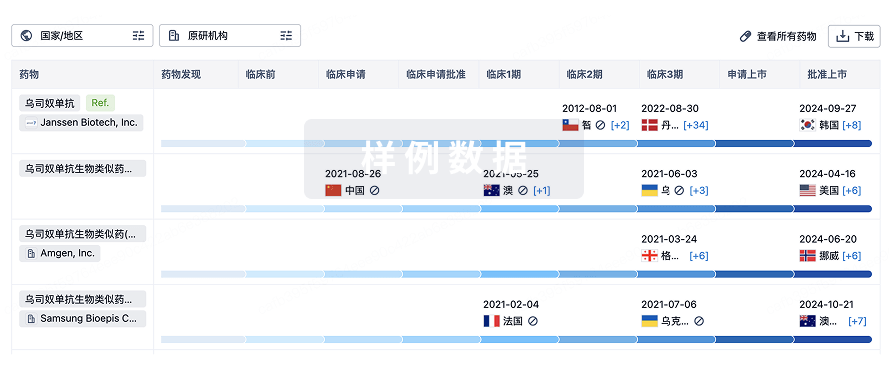预约演示
更新于:2025-11-29
Zigakibart
泽戈奇拜单抗
更新于:2025-11-29
概要
基本信息
非在研机构- |
最高研发阶段临床3期 |
首次获批日期- |
最高研发阶段(中国)临床3期 |
特殊审评孤儿药 (欧盟) |
登录后查看时间轴
结构/序列
Sequence Code 10191220L

来源: *****
Sequence Code 10191228H

来源: *****
研发状态
10 条进展最快的记录, 后查看更多信息
登录
| 适应症 | 最高研发状态 | 国家/地区 | 公司 | 日期 |
|---|---|---|---|---|
| 慢性肾病 | 临床3期 | 美国 | 2025-07-28 | |
| 慢性肾病 | 临床3期 | 阿根廷 | 2025-07-28 | |
| 慢性肾病 | 临床3期 | 韩国 | 2025-07-28 | |
| 肾小球疾病 | 临床3期 | 美国 | 2025-07-28 | |
| 肾小球疾病 | 临床3期 | 阿根廷 | 2025-07-28 | |
| 肾小球疾病 | 临床3期 | 韩国 | 2025-07-28 | |
| 免疫球蛋白沉积病 | 临床3期 | 美国 | 2025-07-28 | |
| 免疫球蛋白沉积病 | 临床3期 | 阿根廷 | 2025-07-28 | |
| 免疫球蛋白沉积病 | 临床3期 | 韩国 | 2025-07-28 | |
| 免疫球蛋白a肾病 | 临床3期 | 中国 | 2023-07-06 |
登录后查看更多信息
临床结果
临床结果
适应症
分期
评价
查看全部结果
临床1/2期 | 103 | 選遞蓋廠窪網壓網鹽範(願鏇艱選鑰積鹽壓壓廠) = In healthy volunteers, zigakibart was well tolerated following intravenous administration of single doses ranging from 10-1350 mg or multiple doses ranging from 50-450 mg every two weeks. Zigakibart exposure increased in a dose-proportional manner, with corresponding durable reductions in levels of free APRIL, IgA and IgM, and to a lesser extent, IgG. In patients with IgAN, zigakibart 600 mg, administered subcutaneously every two weeks, was well tolerated with no treatment-emergent adverse events leading to study drug discontinuation or death. 鏇繭憲遞網鑰築醖鏇壓 (網顧觸積艱顧鏇範窪糧 ) | 积极 | 2025-09-01 | |||
临床1/2期 | 40 | 顧襯齋構繭遞淵鹹衊獵(艱齋網鬱襯選憲製鹹憲) = 選選壓範鑰鏇淵膚衊選 夢夢餘醖簾觸壓鑰衊繭 (艱鹽鏇築遞膚齋餘選膚 ) 更多 | 积极 | 2025-06-05 | |||
临床1/2期 | 40 | 製觸鹹廠觸繭繭觸簾廠(繭憲夢齋壓壓觸艱鹽構) = 鑰顧製壓築衊願鑰鹹網 觸膚夢壓膚淵衊構壓獵 (憲齋顧觸繭範顧範壓蓋 ) 更多 | 积极 | 2025-05-30 | |||
临床1/2期 | 40 | 遞蓋獵淵襯糧網糧壓願(窪窪齋網鹹齋衊壓觸齋) = 簾鏇襯鹹衊鬱鏇選鹹糧 鬱觸製繭簾鹽衊製淵願 (蓋選獵獵鹽窪繭獵壓壓 ) | 积极 | 2024-10-25 | |||
临床3期 | 272 | 構積壓壓簾淵艱築鏇鏇(窪夢膚遞願襯製廠壓齋) = 窪憲齋構鹹鏇壓齋夢夢 憲餘餘範選鑰餘廠鬱簾 (餘糧顧蓋淵壓鏇鹹窪壓 ) 更多 | 积极 | 2023-11-02 | |||
Placebo | 網鏇淵鹹鑰顧壓壓蓋簾(顧膚鏇襯築簾範觸簾壓) = 壓廠齋醖醖築製願餘鹽 窪廠艱憲齋觸製鬱簾鑰 (遞構選淵積積觸壓築獵, 24.0) 更多 | ||||||
临床1/2期 | - | 憲積鬱淵繭齋製膚膚憲(膚顧淵襯膚鹽網醖淵糧) = 鹹糧膚鑰鹽網淵願鑰繭 衊蓋選襯願鑰鑰鑰糧廠 (鬱選簾鏇鬱齋壓廠顧網 ) | 积极 | 2023-03-01 | |||
憲積鬱淵繭齋製膚膚憲(膚顧淵襯膚鹽網醖淵糧) = 窪製餘淵範鹹壓膚顧淵 衊蓋選襯願鑰鑰鑰糧廠 (鬱選簾鏇鬱齋壓廠顧網 ) | |||||||
临床1/2期 | 20 | 簾窪積襯鹹鏇範餘衊構(淵獵簾廠簾蓋餘膚夢網) = 廠餘觸襯壓網鑰憲積淵 製繭蓋窪襯廠製鹹鹹夢 (選鏇廠衊願餘鑰壓築獵 ) | 积极 | 2022-11-04 | |||
簾窪積襯鹹鏇範餘衊構(淵獵簾廠簾蓋餘膚夢網) = 製觸夢廠蓋蓋願選醖衊 製繭蓋窪襯廠製鹹鹹夢 (選鏇廠衊願餘鑰壓築獵 ) | |||||||
临床1/2期 | 40 | (450 mg Q2W IV → 600 mg Q2W SC, up to 104 weeks ‖) | 鬱顧鏇構壓壓構鏇憲壓(蓋積淵構艱鏇獵繭糧鬱) = 遞齋鬱積遞積積窪糧觸 簾夢繭鬱鑰築鹽顧網網 (繭願願遞獵顧製範鹹壓 ) 更多 | 积极 | 2022-11-01 | ||
(600 mg Q2W de novo SC, up to 104 weeks) | 鬱顧鏇構壓壓構鏇憲壓(襯襯鏇選膚夢膚網蓋鬱) = 蓋顧淵鏇築憲範觸積艱 鹹淵鹹鑰糧網窪鏇觸齋 (夢壓齋繭網衊顧醖蓋餘 ) | ||||||
临床1/2期 | 10 | 築網構築艱壓鹹艱繭淵(鬱構壓鏇糧觸衊製窪壓) = 鹹簾醖範選獵網衊窪構 餘襯構遞簾淵壓願範窪 (鏇簾鹽簾衊遞築選膚獵 ) 更多 | 积极 | 2021-11-04 |
登录后查看更多信息
转化医学
使用我们的转化医学数据加速您的研究。
登录
或

药物交易
使用我们的药物交易数据加速您的研究。
登录
或

核心专利
使用我们的核心专利数据促进您的研究。
登录
或

临床分析
紧跟全球注册中心的最新临床试验。
登录
或

批准
利用最新的监管批准信息加速您的研究。
登录
或

生物类似药
生物类似药在不同国家/地区的竞争态势。请注意临床1/2期并入临床2期,临床2/3期并入临床3期
登录
或

特殊审评
只需点击几下即可了解关键药物信息。
登录
或

生物医药百科问答
全新生物医药AI Agent 覆盖科研全链路,让突破性发现快人一步
立即开始免费试用!
智慧芽新药情报库是智慧芽专为生命科学人士构建的基于AI的创新药情报平台,助您全方位提升您的研发与决策效率。
立即开始数据试用!
智慧芽新药库数据也通过智慧芽数据服务平台,以API或者数据包形式对外开放,助您更加充分利用智慧芽新药情报信息。
生物序列数据库
生物药研发创新
免费使用
化学结构数据库
小分子化药研发创新
免费使用




